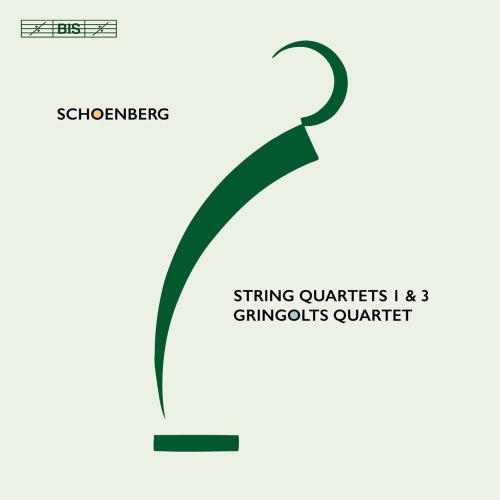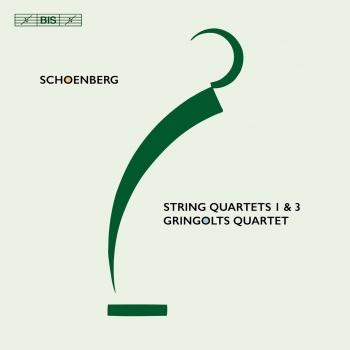
Schoenberg: String Quartets Nos. 1 & 3, Opp. 7 & 30 Gringolts Quartet
Album info
Album-Release:
2022
HRA-Release:
01.04.2022
Label: BIS
Genre: Classical
Subgenre: Chamber Music
Artist: Gringolts Quartet
Composer: Arnold Schoenberg (1874-1951)
Album including Album cover Booklet (PDF)
- Arnold Schoenberg (1874 - 1951): String Quartet No. 1 in D Minor, Op. 7:
- 1 Schoenberg: String Quartet No. 1 in D Minor, Op. 7: I. Nicht zu rasch 13:39
- 2 Schoenberg: String Quartet No. 1 in D Minor, Op. 7: II. Kräftig 12:15
- 3 Schoenberg: String Quartet No. 1 in D Minor, Op. 7: III. Mäßig 12:15
- 4 Schoenberg: String Quartet No. 1 in D Minor, Op. 7: IV. Mäßig 08:29
- String Quartet No. 3, Op. 30:
- 5 Schoenberg: String Quartet No. 3, Op. 30: I. Moderato 08:57
- 6 Schoenberg: String Quartet No. 3, Op. 30: II. Adagio 08:43
- 7 Schoenberg: String Quartet No. 3, Op. 30: III. Intermezzo. Allegro moderato 07:21
- 8 Schoenberg: String Quartet No. 3, Op. 30: IV. Rondo. Molto moderato 06:48
Info for Schoenberg: String Quartets Nos. 1 & 3, Opp. 7 & 30
Arnold Schoenberg’s second string quartet – included on a previous release by the Gringolts Quartet – is often used as a reference point when the emergence of atonality is discussed. That work, where Schoenberg in the fourth movement suddenly does away with a time signature, was composed in 1907, three years after his first work in the genre: the String Quartet in D minor, Op. 7, a work which still has much in common with the Late Romantic idiom of Richard Strauss.
The D minor quartet is in one movement, but with four distinct sections which, according to a note left by the composer, chart a progression from ‘rebellion’ and ‘depression’ to ‘quiet joy and the contemplation of rest and harmony’ – a programme reminiscent of the one Strauss had used in his recent tone poem Ein Heldenleben. Albeit tonal, the harmonic language is richly chromatic, pointing forward to the inevitable break in the second quartet. Some twenty years later, Schoenberg had developed his twelve-tone method, and his Third Quartet is an example of how he was using this to refresh traditional form schemes and contrapuntal textures, while at the same time counterbalancing the modern idiom with familiar features such as a slow variation movement and a rondo finale.
Gringolts Quartet
Gringolts Quartet
The Zurich-based Gringolts Quartet was founded in 2008, born from mutual friendships and chamber music partnerships that cross four countries: over the years, the Russian violinist Ilya Gringolts, the Romanian violist Silvia Simionescu and the Armenian violinist Anahit Kurtikyan frequently performed together in various chamber formations at distinguished festivals; the German cellist Claudius Herrmann played with Anahit Kurtikyan in the renowned Amati Quartet.The quartet has collaborated with eminent artists such as Leon Fleisher, Jörg Widmann, David Geringas, Malin Hartelius, Christian Poltéra and Eduard Brunner. In addition to playing the classical quartet repertoire, the members are also dedicated performers of contemporary music, including works by Marc-André Dalbavie, Jörg Widmann and Jens Joneleit. Highlights from past seasons include performances at the Salzburg, Lucerne and Gstaad Menuhin Festivals, St Petersburg Philharmonia, L’Auditori Barcelona, Oleg Kagan Musikfest in Kreuth, Sociedad Filarmónica de Bilbao, Società dei Concerti in Milan and the Kasseler Musiktage.
The members of the Gringolts Quartet all play on rare Italian instruments. Ilya Gringolts plays a Giuseppe Guarneri ‘del Gesù’ (1742–43), Anahit Kurtikyan plays a Camillo Camilli violin (Mantua 1733), and Silvia Simionescu plays a Jacobus Januarius viola (Cremona 1660). The cello of Claudius Herrmann was built by Giovanni Paolo Maggini in Brescia in 1600 – an instrument once owned by Prince Galitsin, and used at the first performances of three of Beethoven’s last quartets, commissioned by the Prince.
Booklet for Schoenberg: String Quartets Nos. 1 & 3, Opp. 7 & 30













